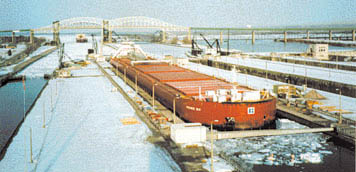Feds release down payment for new Soo Lock
Date Posted: December 7 2001
The federal government has approved the first $3 million to start construction of a new lock through the St. Mary's River in Sault Ste. Marie. The total construction cost is expected to be $225 million.
There are currently four locks at the Soo: The largest and most important is the 1,000-foot long by 105-foot wide Poe Lock, which was completed in 1968 and handles the biggest ore- and bulk-cargo freighters. Also at the Soo are McArthur Lock (completed in 1944, 800 ft. long by 80 ft. wide) and the smaller Davis and Sabin locks, which were built more than 80 years ago.
Plans call for removing the Davis and Sabin locks and replacing them with a larger lock.
"The new lock would be identical in size to the Poe," said Stanley Jacek, Soo-area engineer for the Army Corps of Engineers. Why not make it bigger? "If you make that new lock bigger, then they're going to make the ships bigger, and they wouldn't be able to fit through the Poe Lock, and that would defeat the whole purpose of having a backup," Jacek said. "We want to be able to shut down one lock during the warmer months for service and use the other lock."
Currently, maintenance on the Poe Lock must be done in the winter, when freighter traffic comes to a halt. In fact, Jacek said this winter, the Poe lock is undergoing extensive repairs. And all large freighter traffic through the northern Great Lakes would come to a halt in the summer if the Poe Lock ever broke down for any length because there isn't an alternative lock. U.S. Rep. Bart Stupak (D-Menominee) said work on the estimated five-year project to install the new lock could start as early as next year. Jacek said cofferdam installation to move water out of the way will be first on the to-do list.
"If the Poe Lock is rendered unusable for any reason, it would disable industry in the Great Lakes, halting the shipment of ore, coal, wheat, and other commodities," Stupak told a House subcommittee last year. "The steel industry would be especially hard hit as 70 percent of all raw materials used in the steel industry travel through the Soo Locks."
The locks are necessary because they permit ships to travel around a 21-foot waterfall on the St. Mary's River. Lake Superior is 21 feet higher than the other Great Lakes. Approximately 5,000 boats use the locks every year.
The history of the Soo Locks began in 1797, when the Northwest Fur Company built a lock 38 feet long on the Canadian side of the river for small boats. This lock remained in use until it was destroyed in the War of 1812. Freight and boats were portaged around the rapids until another lock was built.
Congress passed an act in 1852 for the construction of two new locks, which were completed in 1855. In 1881 the locks were transferred to the U.S. government under the jurisdiction of the U.S. Army Corps of Engineers. The Corps has operated the locks, toll free, since then.

U.S. Rep. Bart Stupak said he has worked almost his entire congressional career trying to obtain funds for a new large Soo lock, noting that 90 million tons of freight moves through the locks each year.
Photo by Carmen Paris, U.S. Army Corps of Engineers
